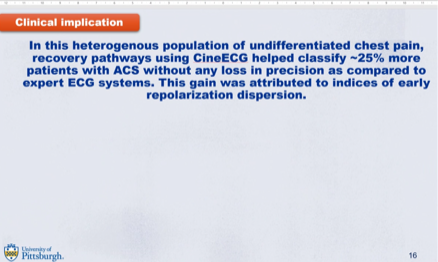CineECG makes 12 -lead ECG interpretation easier & better
Results within
seconds
same ECG data gives new views on heart
Save
Costs and
Diagnostic
time
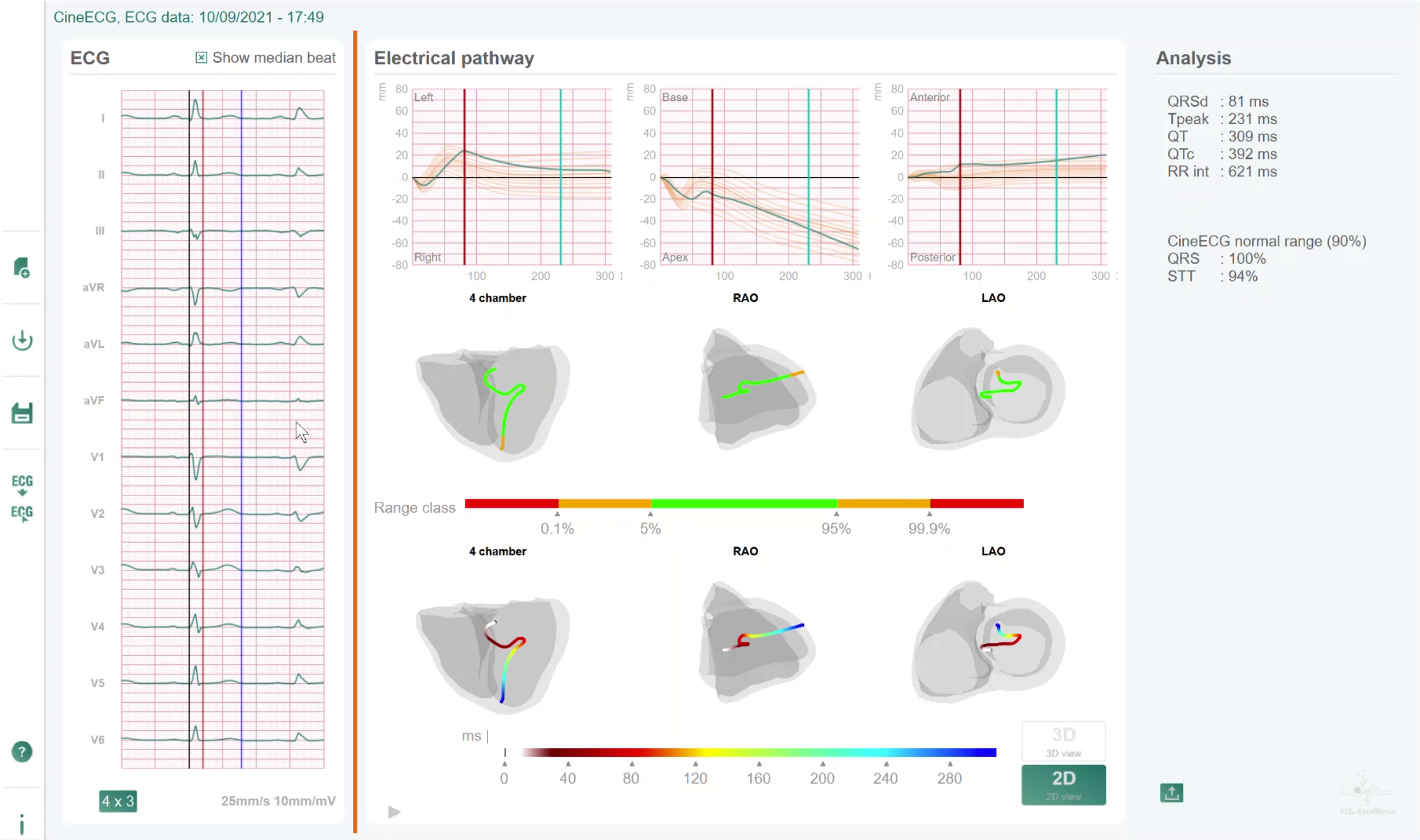
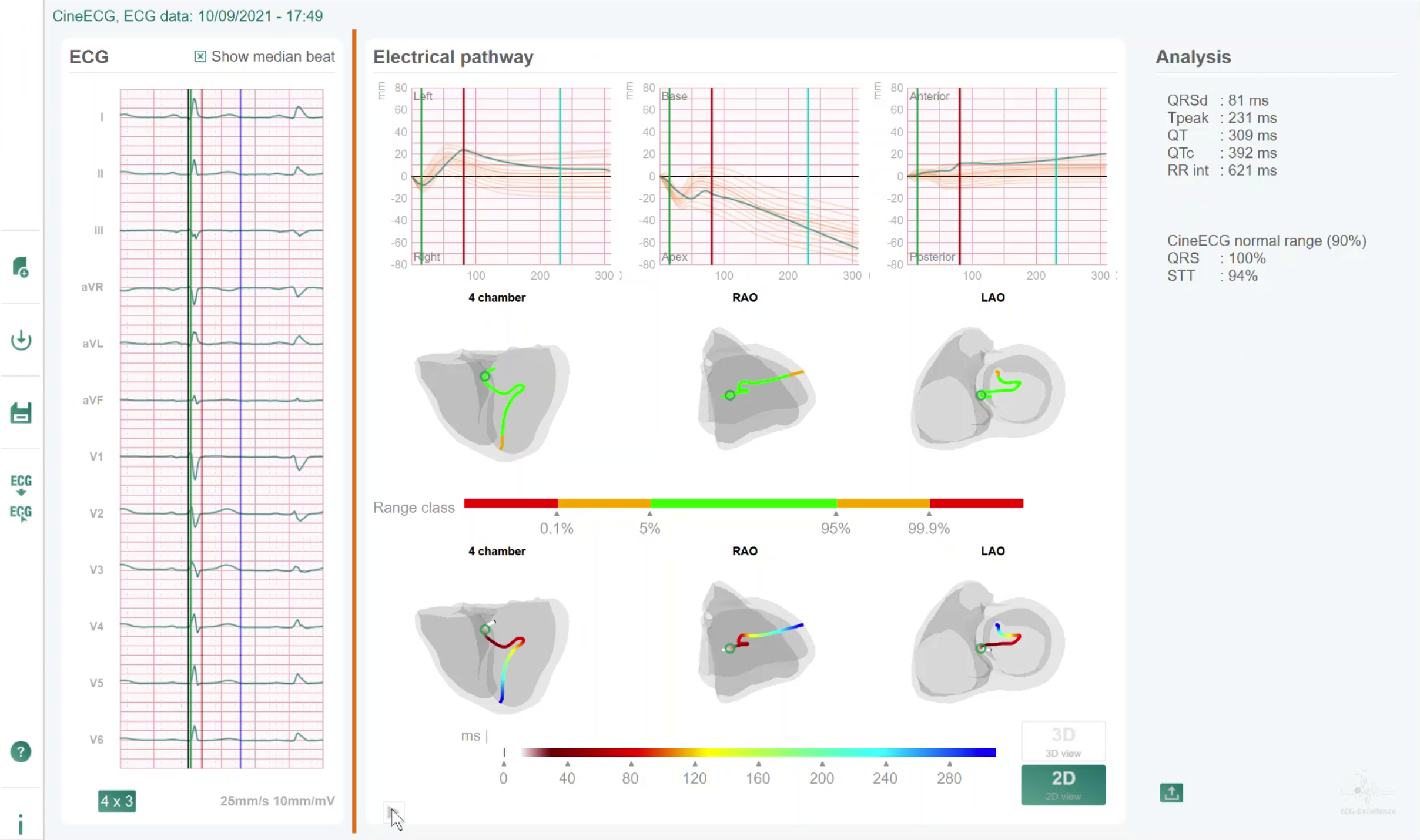
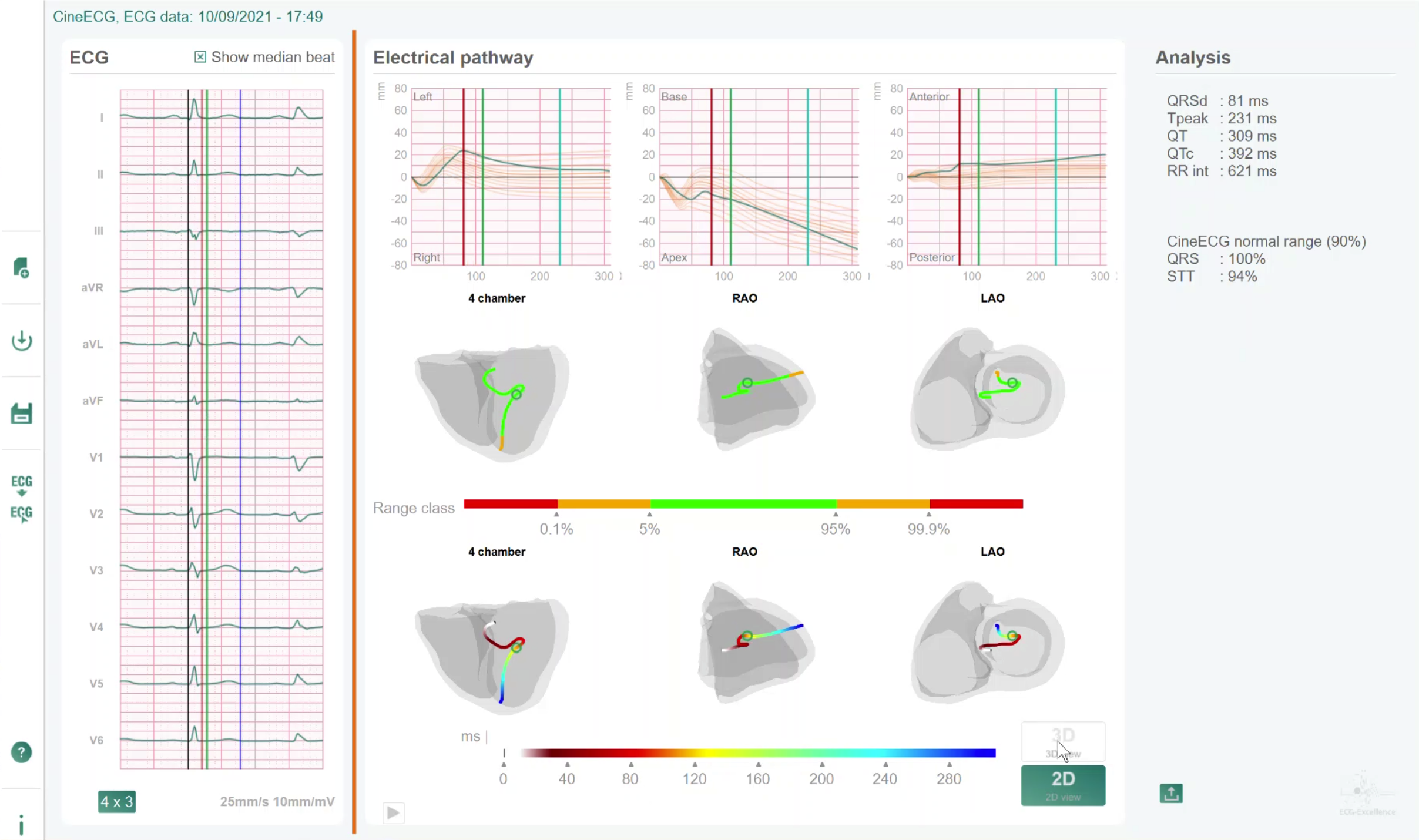
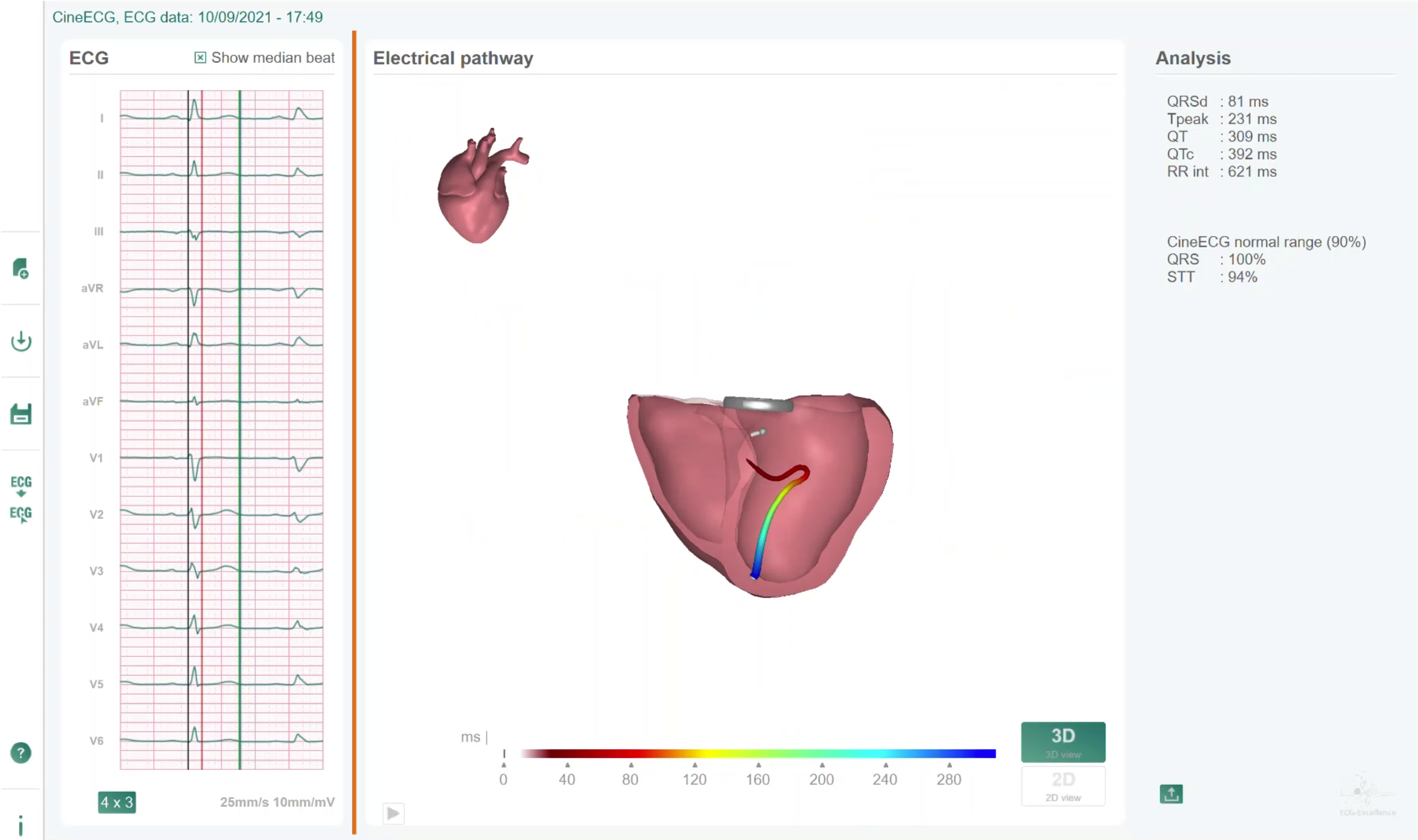


CineECG Insights
Academic recognition for CineECG
We have a winner with CineECG
CineECG classifies +25% more patients with ACS
CineECG: a new approach to ECG data interpretation and visualisation
CineECG is a software solution which supports ECG waveform interpretation. CIneECG makes 12 lead ECG waveform interpretation EASY & BETTER. CineECG only uses standard 12 lead ECG data to present instant complementary views on the heart performance. CineECG informs on the level of normality of the recorded ECG values. CineECG makes transparant what is happening in both QRS, ST segment and T waves. In much more detail and accuracy then standard practive today. CineECG can be used via multiple channels: Via our platform (Opt for a free trial or use the Go To Platform button) or via trusted partners who have integrated CineECG in their ECG interpretation services. For more information on the trusted partner option please contact us. CineECG is only available in a research only version at this moment.
How does it work?
Step 1
Step 1
Step 1
Step 2
Step 2
Step 2
Step 3
Step 3
Step 3
Step 4
Step 4
Step 4
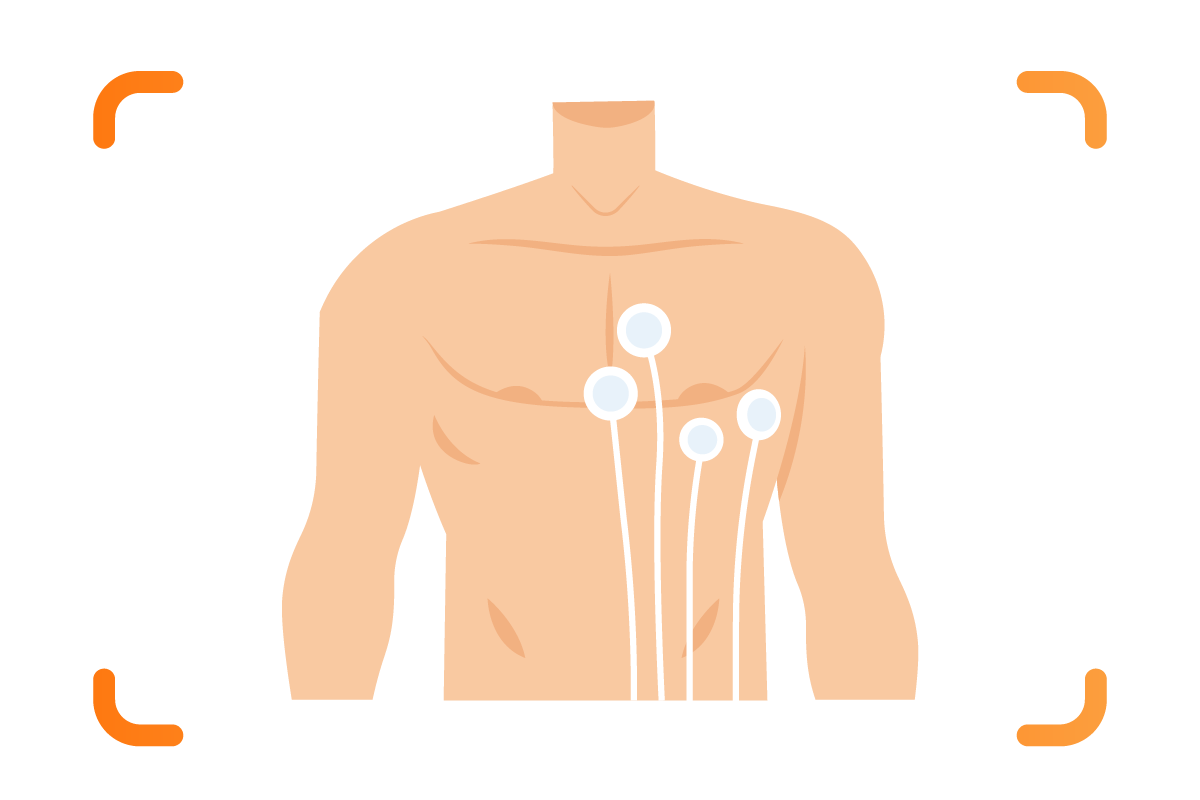
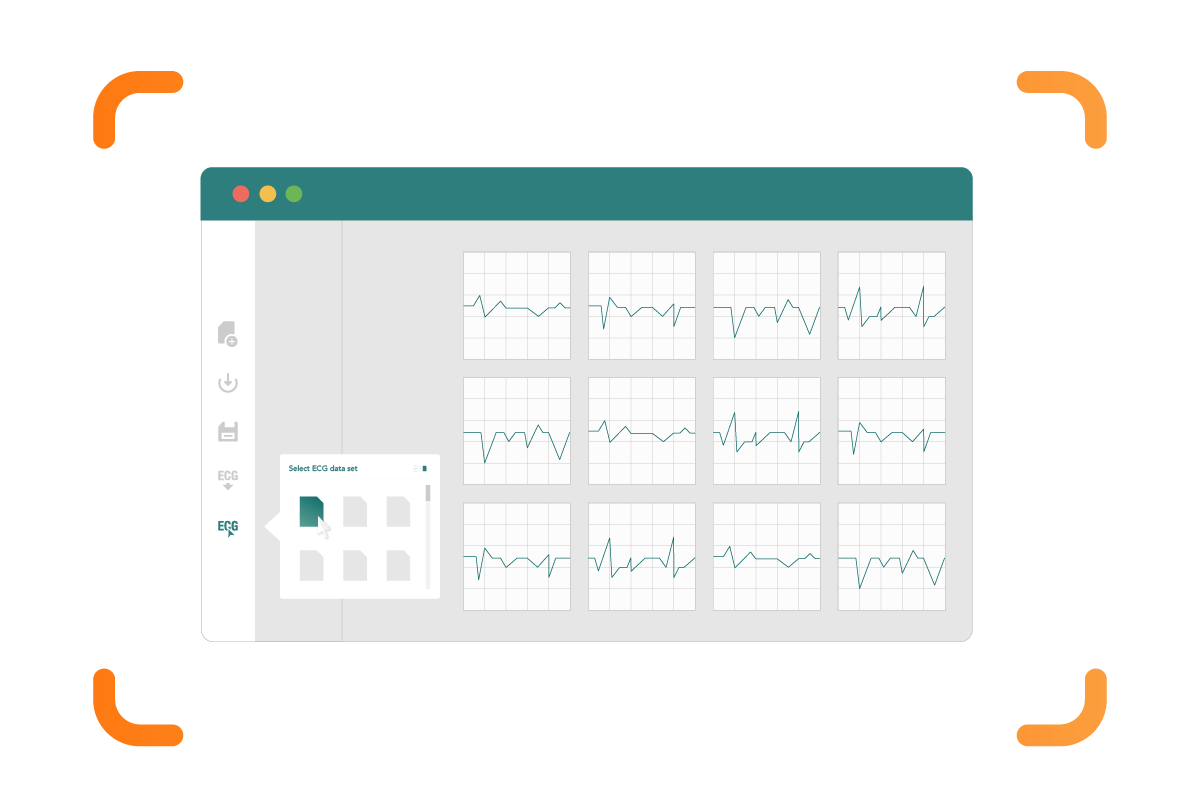
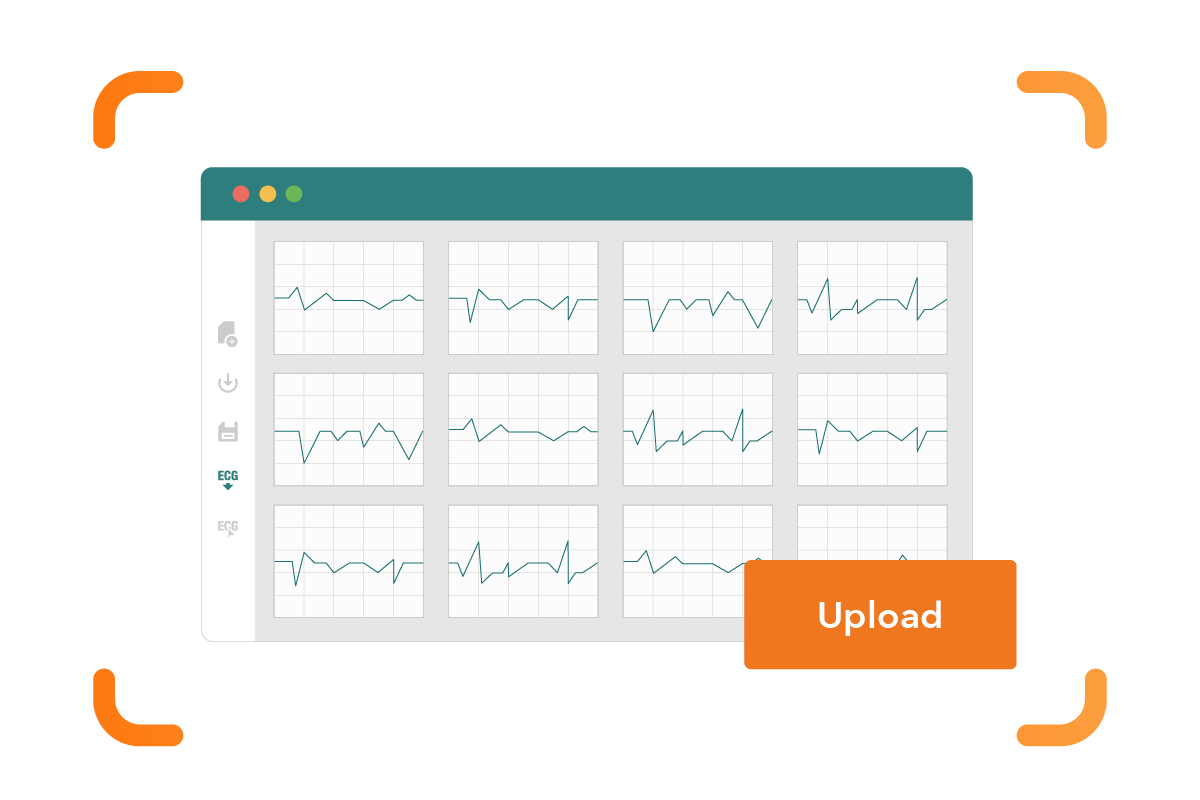
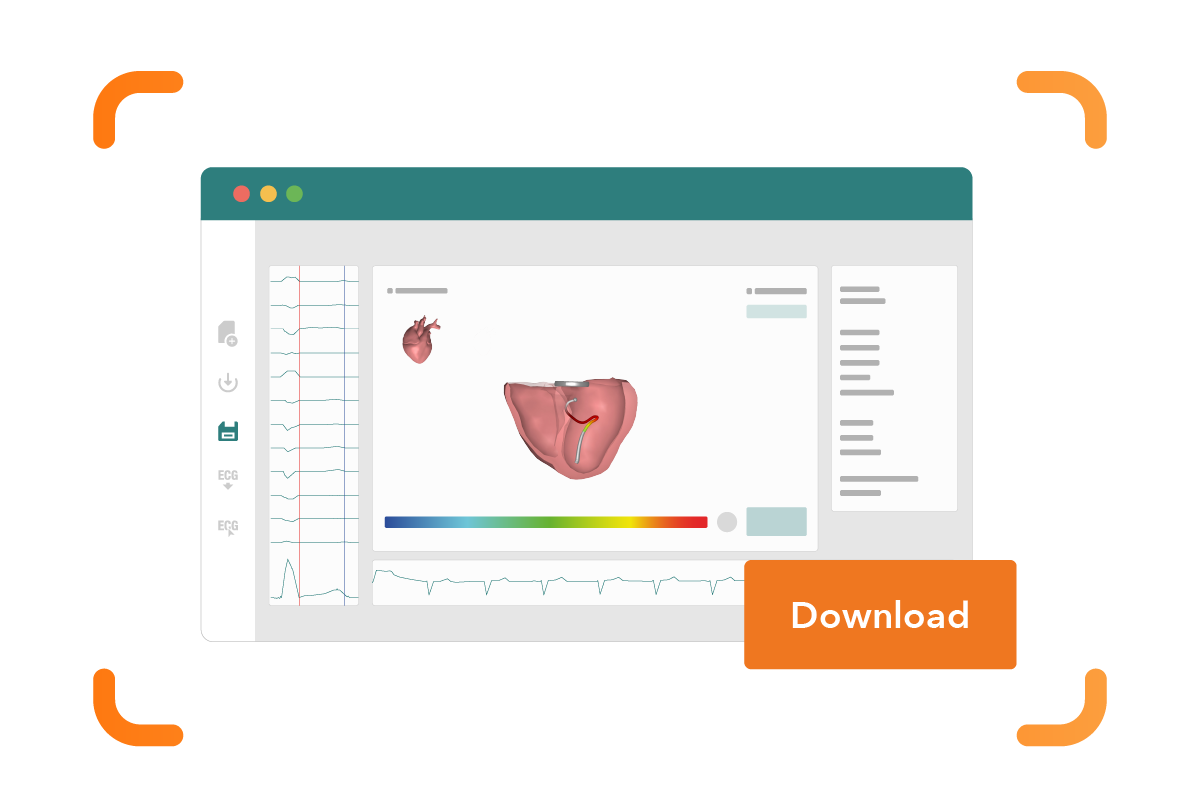
Example report
Page 1 has 3 segments. Here you can see Segment C.
Segment C shows the rhythm strip per lead as uploaded by the user of the system. Please download the CineECG report explanation to see the full report and explanation for the other segments.

Segment A shows the median beat of the recorded ECG data which has been uploaded by the user. These 12 QRS-T complexes are presented in the standard lead-order. Segment B shows the derived CineECG based on the miedian beat ECG data. Orange trajectories are averaged over 6500 normal ECGs (PTB XL database) from different age groups and are for reference only.
Please download the CineECG report explanation to see the full report and explanation for the other segments.
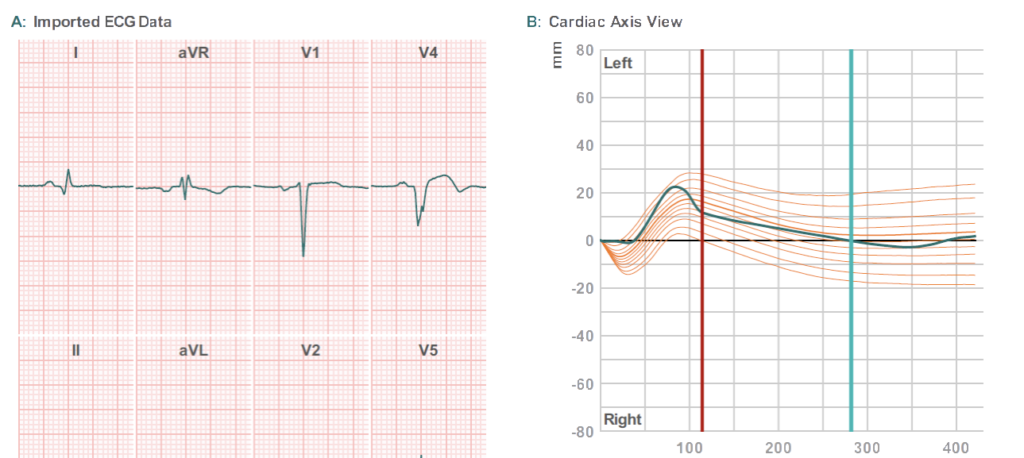
Segment D shows the CineECG electrical pathway of the median ECG beat through the heart. The color of the pathway indicates if the uploaded electrical pathway is in line within the CineECG pathway range of normal healthy ECG’s, The color green indicates alignment with 90% of the normal values per time sample, amber indicates a value outside the normal values but within the 99.9% range, and the red color indicates when the cineECG is outside the range of normal values.
Please download the CineECG report explanation to see the full report and explanation for the other segments.

Example report page 1
Segment A shows the median beat of the recorded ECG data which has been uploaded by the user. These 12 QRS-T complexes are presented in the standard lead-order.
Segment B shows the derived CineECG based on the median beat ECG data. CineECG views are along 3 cardiac axes, left-right, base-apex and anterior posterior. Orange trajectories are averaged over 6500 normal ECGs (PTB XL database) from different age groups and are for reference only.
Segment C shows some ECG de- and repolarization values and the percentage that falls within the normal range, based upon the position of the blue line with respect to the orange line(s).
Finally, the page shows the legend for the CineECG report.
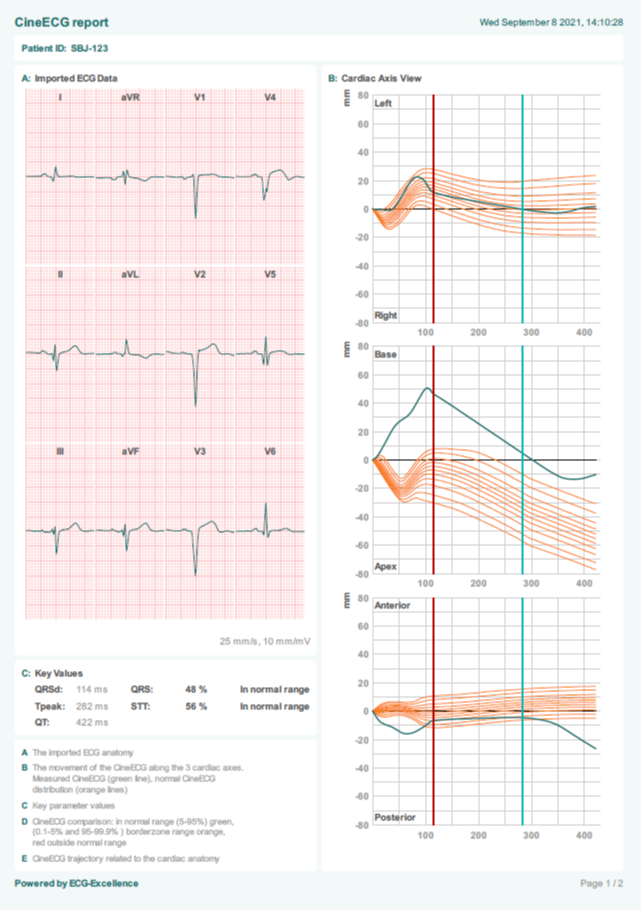
Example report page 2
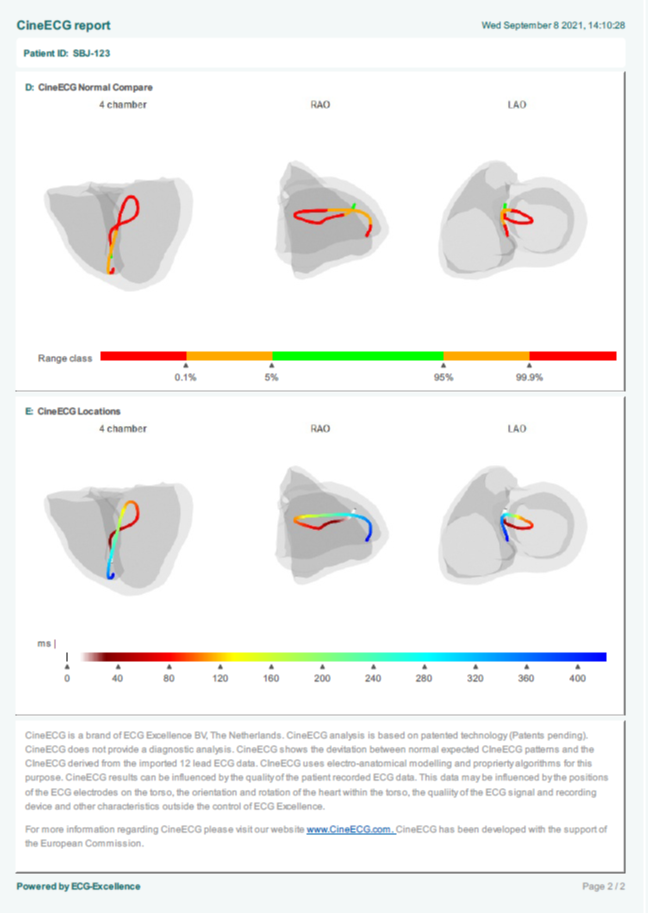
Example report page 3
Page 3 has x segments.
Segment D shows the CineECG electrical pathway of the median ECG beat through the heart. The color of the pathway indicates if the uploaded electrical pathway is in line within the CineECG pathway range of normal healthy ECG’s, The color green indicates alignment with 90% of the normal values per time sample, amber indicates a value outside the normal values but within the 99.9% range, and the red color indicates when the cineECG is outside the range of normal values.
Segment E again shows the CineECG in the 3 standard cardiac views. Where the black/white part indicates the onset QRS of the CineECG position in the heart, the red color the QRS trajectory, and the yellow/blue part the STT segment CineECG trajectory of the median beat.
Finally, the page contains generic information regarding CineECG and provides a link to the CineECG.com website.

Still not convinced? Let our partners speak for us
The companies supporting CineECG





Flexible pricing options
On our HealthCOR platform you can select your billing option during registration and log in
Pay per use
- With or without account
- Report within 10 seconds
- Monthly invoice with account
- Maximum flexibility
Wallet / Credit
- 1 account
- 1 or more users
- Access to previous reports
- Maximum freedom to use
Subscription
- Monthly fee
- Unlimited number of cases
- Unlimited number of users
- Best option for over 200 CineECG reports per month
Learn from others before you
Your questions answered...
Your questions might have already been answered in the following categories.
There are 2 options for registration:
- Sign up for our newsletter (name, email, telephone number)
- Send us your contact data (name, email, organisation) to request a CineECG report and analysis on your ECG data (this if for medical professionals only)
Please send an email to info@cineecg.com
or click on unsubscripe in the newsletter email
Yes, we will only correspond to you through the newsletter emails and newsletter attachments. Your data will not be shared with other organisations.
The following digital ECG formats will be supported:
- DICOM ECG containing the CIOD types “12-lead ECG” or “General ECG” according the DICOM specification. The file extension MUST be “.dcm”.
- Binary formatted ECG files, the file extension MUST be “.ecg”:
- ISHNE generic format (only non-holter, resting ECG recordings supported),
- Fysiologic recorder.
- The following XML formatted files are supported, the file extension MUST be “.xml”:
- FDA HL7 AnnotatedECG,
- Hillrom/Baxter/Mortare EliLink exported XML-MI,
- GE-Muse RestingECG,
- Philips XML restingecgdata SierraECG versions 1.03, 1.04, 1.04.01 and 1.04.02.
- Stryker ECGRecord
At this moment this is not possible. Only digital ECG data formats are accepted by our system. In future we intend to provide a PDF to Digital conversion service.
The CineECG adds the direct relation between the standard 12 lead ECG and the cardiac anatomy. This provides a novel anatomical view on the ECG. We also compare the results of the CineECG analysis to normal distribution of CineECG values for normal healthy heart performances.
In this section you will find the standard visual presentation of the uploaded ECG data in 12 graphs. You will also find a limited number of numeric values derived from the uploaded data following an algorithm which is based on the BRAVO algorithm powered by AMPS-LLC
For a detailed description we refer you to the tutorials section where you can find a document with the description of the information provided in the report
The origin of the normal CineECG output is a public ECG data set: Wagner P, Strodthoff N, Bousseljot RD, Kreiseler D, Lunze FI, Samek W, et al. PTB-XL, a large publicly available electrocardiography dataset. Sci Data. 2020;7(1):154. The process which we have followed in deriving the normal CineECG’s has been published in an article: van Dam PM, Boonstra M, Locati ET, Loh P. The relation of 12 lead ECG to the cardiac anatomy: The normal CineECG. Journal of Electrocardiology. 2021;69:67-74.
The CineECG changes its location over time within the cardiac space. The CineECG locations have been determined for 6500 normal ECGs of the PTB XL database, thereby setting boundaries for normal CineECG locations. When the CineECG stays within this “normal cardiac space” the CineECG is conform these normal locations.
For a detailed description we refer you to the tutorials section where you can find a document with the description of the information provided in the report
The CineECG report is only available in PDF format
CineECG has been validated through a growing number of scientific studies. For these studies we used a retrospective approach and used ECG data sets which have been qualified.
All the CIneECG validation stem from collaborations between ECG Excellence and teams of expert universities in Europe.
The validation regarding the normal CineECG values has been conducted by using a public available ECG database.
All publications underpinning the validation of CIneECG have been published in peer to peer reviewed scientific journals
CineECG validation is an ongoing journey. Every new ECG data set adds further value to the validation process and the tuning of the algorithms. CineECG is a result of earlier R&D regarding the use of computerized modelling to create simulations of a persons cardiac activation and recovery processes. The process of computerized modelling and especially the inverse variant in modelling has its roots in Dutch universities. During the past century this work has started and has resulted in ever improving computerized models of heart and torso to understand cardiac activation and the impact of tissue conduction, tissue quality and skin positions of electrodes.
The team behind CineECG has continued this journey and has found solutions to relate ECG data to the heart anatomy and has developed algorithms to show electrical pathways through this anatomy. The scientific base for the CIneECG technology is extensive and if you are interested we advice you to download the R&D portfolio summary on the “about” page.
The history of CIneECG dates back at least 5 years and todays result has been achieved by collaboration with a number of organisations:
- University Medical Center Utrecht
- IRCCS Policlinico San Donato Milanese
- Radboud University Nijmegen
- Basel University Hospital
- HochSchule Lucern
- Peacs BV
- Dutch Heart Foundation
- Eureka/Eurostars innovation support
At this moment CineECG has been tested for a limited number of cardiac disorders. Testing the added value of CineECG in detecting additional cardiac disorders is proceeding on a ongoing base. However the current version of CineECG is RESEARCH ONLY. The CIneECG report only shows the level of conformity between normal values and the recorded values.
You can find information in our R&D portfolio which can be downloaded on the ”about” page
Please contact our team via the request further information box or send an email to info@cineecg.com
At this moment in time CineECG is not CE MDR certified. CineECG does not provide a diagnostic output but only shows the level of conformity between normal CineECG and the recorded data. Furthermore, the current beta version of CineECG is only available for research purposes.
CineECG is in the process of being qualified for a CE MDR certification class IIa. This is needed for providing diagnostic feedback in the next versions of CineECG.
The companies supporting and developing CineECG are working in the ISO13485 modus and are in the process of certification of their quality management systems.
Our support is delivered by answers provided in a) these FAQ section of our CineECG website; b) in the tutorials which are also made available through this website (at this moment the tutorials are in PDF format but we will add video based explanations of the key CIneECG processes in the near future and c) by contacting our team via the dialogue box provided on the website or via sending an email to info@cineecg.com.
We will either respond to you by email or if this is needed we will contact you for a bilateral conversation in which we can assist you even better.
by contacting our team via the dialogue box provided on the website or via sending an email to info@cineecg.com.
We will either respond to you by email or if this is needed we will contact you for a bilateral conversation in which we can assist you even better.
Please contact our team via the dialogue box in CineECG.com
We are trying to answer all information requests within 48 hours in normal work days. If you send us a question during the weekend this response time may be a little longer.
We offer 3 billing options:
1) a Pay per Use option. In this option you will need to submit a payment to enable access to the ECG data set upload function. You will receive an invoice per email.
2) a Wallet/Credit option. In this option you will have to register an organisation first and in a second step allocate users from within the organisation. The system requires a deposit / payment first before the ECG data set upload function can be used by any of the registered users within an account. The costs per CineECG analysis are similar to the Pay per Use option
3) a CineECG subscription option. In this option you will need to register an organisation and have the option to provide access to max 4 users. The subscription fee is on a monthly base and after the initial payment the users have unlimited access to the CineECG service during the running month
We do not provide an automated wallet return option. The remaining funds in the wallet will be available for running CineECG analysis as long as the funds are sufficient.
Please send a request for returning remaining funds via our dialogue box. For this return option we charge 10% admin costs with a minimum amount of €10
Our systems shows the available funds within your wallet and if the funds are no longer sufficient a message will show you need to deposit additional funds in the wallet or select Pay per Use for the particular ECG analysis
No, for this moment we only offer a monthly invoice frequency
After you have made a payment on the Healthcor platform we will send an invoice to the email address you have provided in the Profile section. The invoice will be send some 10-15 minutes after you have made the payment. If you want to look at your invoicing history you can go to the profile section and click on the button subscription billing details on the right side of the page. This will bring you to your invoicing history. On this page you can also change the email address you want to use for your invoicing process.
When you increase the amount of money in your wallet the system will send you an invoice of the transaction. At the end of each month you will receive another invoice (with the same invoice number) detailing the actual usage of the system and the analysis runs billed against the wallet.
The scientific base of CineECG and the domain of added value is constantly challenged and enlarged by our team. We expect to use CineECG for identification of more conduction related cardiac disorders both in the atria and the ventricles.
We are also planning to launch desktop and or Hospital Information System versions which will provide more functionality to users of CineECG. The interactive version of CineECG may support comparing CineECG’s from a same patient, beat selection-based analysis, selecting between 3D and 2D views, zooming function to explore more details. We also aim to work to a more patient specific solution of CineECG incorporating 3D photo derived information on the patient.
Yes, ECG Excellence has embarked on a mission to improve the ECG interpretation through digital twin-based technologies. A next step in this approach is to further increase the personalisation of the data collection and data processing. In order to achieve this, we are developing a technology which can easily capture the actual ECG electrode positions on the torso and derive the heart orientation from physical characteristics of the torso.
The vision guided ECG recording technology will also contain an ECG electrode positioning support facility which will show the operator where to place the electrodes on the torso, taking a person’s physical characteristics into account. Or apply a disease specific electrode configuration. This system will also support re-positioning of ECG electrodes at the same locations during a next ECG recording session.
Please contact our team via the dialogue box in CineECG.com
Since CineECG is a SAAS service software upgrades will occur but not be made visible for users of the system.
Please contact our team via the dialogue box in CineECG.com
At this moment CineECG is available through
a) the HealthCOR platform which can be reached by clicking on the GO TO PLATFORM button on the menu or by using the FREE TRIAL option offered on this website (CineECG.com)
b) through the ECG Interpretation services of Fysiologic Smart ECG solutions. For more information on these services see their website https://www.Fysiologic.nl
we expect other service providers to also start offering CIneECG in the near future.
The HealthCor platform provides a fully automated ECG analysis service. Our algorithms and cardiac computational modelling convert the ECG data and run a basic heart rhythm analysis (based on the Bravo algorithm) and the conduction analysis (CineECG). The analysis is integrated into a single report which is made available second after the upload of the data. The physician who is the user of the CineECG service has to interpret the CineECG report.
The other route is to use human interpretation expertise for which the expert is supported by software including CineECG analysis. This type of ECG interpretation service supports the physician in delivering an expert interpretation of the ECG data set. On average the throughput time of this type of advice is at least 30 minutes but may require hours.
The Healthcor platform can be directly approached through this website. After providing your profile and billing data you can start working with CineECG.
For the indirect way you need to contact our partner organisation to arrange a contract with conditions
Of course, please fee free to use the information on this website and communicate with us and / or share your insights and experiences with CineECG.
The scientific base of CineECG and the domain of added value is constantly challenged and enlarged by our team. We expect to use CineECG for identification of more conduction related cardiac disorders both in the atria and the ventricles.
We are also planning to launch desktop and or Hospital Information System versions which will provide more functionality to users of CineECG. The interactive version of CineECG may support comparing CineECG’s from a same patient, beat selection-based analysis, selecting between 3D and 2D views, zooming function to explore more details. We also aim to work to a more patient specific solution of CineECG incorporating 3D photo derived information on the patient.
Yes, ECG Excellence has embarked on a mission to improve the ECG interpretation through digital twin-based technologies. A next step in this approach is to further increase the personalisation of the data collection and data processing. In order to achieve this, we are developing a technology which can easily capture the actual ECG electrode positions on the torso and derive the heart orientation from physical characteristics of the torso.
The vision guided ECG recording technology will also contain an ECG electrode positioning support facility which will show the operator where to place the electrodes on the torso, taking a person’s physical characteristics into account. Or apply a disease specific electrode configuration. This system will also support re-positioning of ECG electrodes at the same locations during a next ECG recording session.
Please contact our team via the dialogue box in CineECG.com
Since CineECG is a SAAS service software upgrades will occur but not be made visible for users of the system.
Please contact our team via the dialogue box in CineECG.com
You can now go to the services page and select the CineECG service.
In our tutorial you can see how to do this and which button you need to switch.
Our platform will soon be offering other services than CineECG and this activation provision is built in to ensure a wallet is only available for a specific kind of service.
Ask for a demo of CIneECG or forward another question
We are ready to show you how CineECG can help you evaluating a patients heart performance. Do not hesitate to submit your question or demo request
and we will answer as soon as possible.


